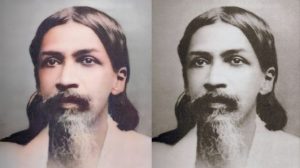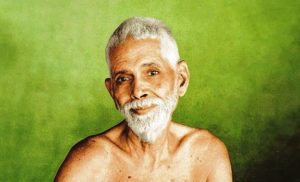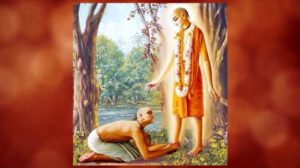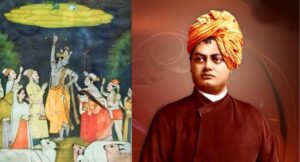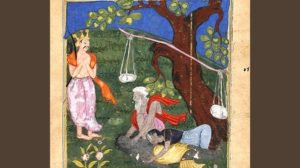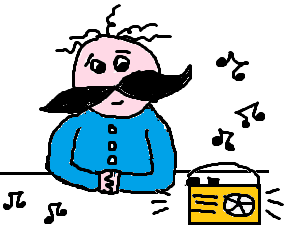Foreword to the Summary of the Ramayana
The Ramayana is the first of India’s most ancient spiritual epics. It predates even the Mahabharata, which itself is at least 3,500 years old. The Ramayana narrates the life story of Rama and Sita, the two great Incarnations of God.
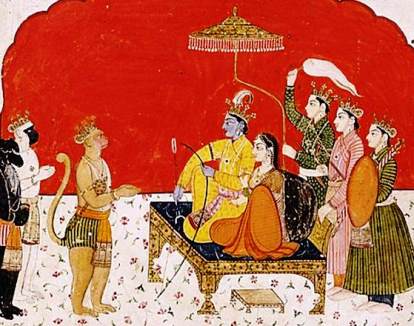
(17th century painting from Himachal Pradesh, courtesy LACMA)
Rama being the incarnation of “Chit”, the infinite ocean of Cosmic Consciousness (also known as Brahman or God in Vedanta); and Sita being the incarnation of “Chit-Shakti”, the dynamic Force of this same Cosmic Consciousness, which is responsible for creating the entire Universe.
In Hindu literature Ram and Sita are also considered as incarnations of Vishnu and his consort Lakshmi, both of whom represent certain specific attributes of Chit and Chit-Shakti respectively.
The story of the Ramayana was first composed as a Sanskrit poem by sage Valmiki. Later, when thousands of years had passed and Sanskrit had ceased to be a language known to the common person and had instead become restricted to the learned Brahmins, there arose in India a great saint by the name of Tulsidas in the 16th century.
Tulsidas once again brought the Ramayana to the intellectual doorstep of the ordinary Indian by retelling its story in the Awadhi dialect of the commoner. Tulsidas’ popular retelling of the Ramayana is known as the Ramcharitmanas.
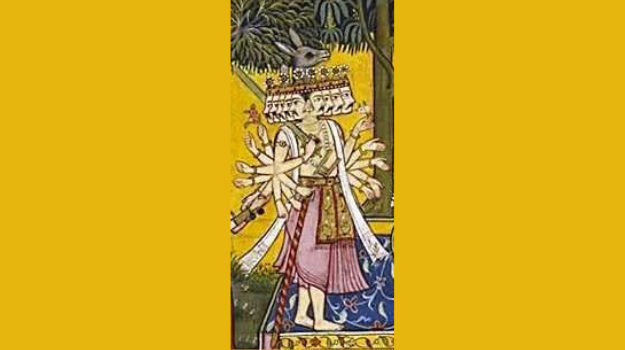
(Painting courtesy the Mewar Ramayana)
Thus there are two versions of the Ramayana in India – the original by Valmiki and the second by Tulsidas. The original telling by Valmiki comprises 24,000 verses spanning seven books, and it forms the subject of the following summary of the Ramayana that was narrated by India’s great spiritual mind, Swami Vivekananda, before an American audience in Pasadena, California in the year 1900.
Now to further enliven the reading experience, Swami Vivekananda’s summary of the Ramayana has been enhanced with beautiful paintings from a 17th century copy of the Valmiki Ramayana that was commissioned by Maharana Jagat Singh of Mewar.
This priceless hand-painted and hand-written manuscript is known today as the Mewar Ramayana. It contains nearly 450 illustrations capturing captivating scenes from the Ramayana. Each painting is so detailed that it tells an entire story, with many successive scenes drawn on one page itself.
The Mewar Ramayana was a project of immense labour which took 5 years (1649-1653) to complete. Later during the British rule several of its volumes got dispersed – some were gifted away by the Maharana’s successors to Colonel James Tod of Britain. But today all the dispersed volumes of the Mewar Ramayana have been digitally reunified into a most wonderful presentation by the British Library which can be viewed here. This presentation takes a few minutes to load as it contains scanned images, so do be patient.
The Ramayana – A Summary by Swami Vivekananda
Delivered at the Shakespeare Club, Pasadena, California, January 31, 1900.
Introduction to the Ramayana
There are two great epics in the Sanskrit language, which are very ancient. Of course, there are hundreds of other epic poems. The Sanskrit language and literature have been continued down to the present day, although, for more than two thousand years, it has ceased to be a spoken language.
I am now going to speak to you of the two most ancient epics, called the Ramayana and the Mahabharata. They embody the manners and customs, the state of society, civilization, etc., of the ancient Indians. The oldest of these epics is called Ramayana, “The Life of Rama”. There was some poetical literature before this — most of the Vedas, the sacred books of the Hindus, are written in a sort of metre — but this book is held by common consent in India as the very beginning of poetry.
The Transformation of Valmiki, Author of the Ramayana, from a Robber into a Sage
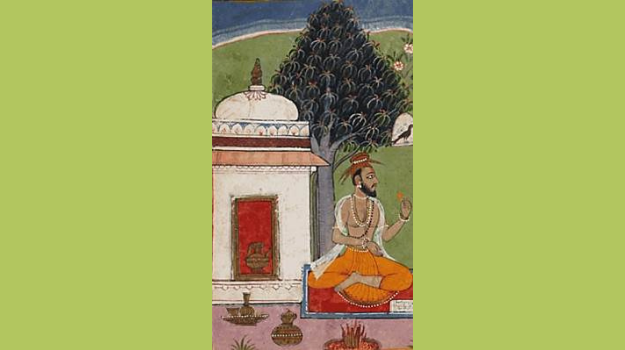
(Courtesy: The Mewar Ramayana)
The name of the poet or sage was Valmiki. Later on, a great many poetical stories were fastened upon that ancient poet; and subsequently, it became a very general practice to attribute to his authorship very many verses that were not his. Notwithstanding all these interpolations, it comes down to us as a very beautiful arrangement, without equal in the literatures of the world.
There was a young man that could not in any way support his family. He was strong and vigorous and finally, became a highway robber; he attacked persons in the street and robbed them, and with that money he supported his father, mother, wife and children.
This went on continually, until one day a great saint called Narada was passing by, and the robber attacked him. The sage asked the robber, “Why are you going to rob me? It is a great sin to rob human beings and kill them. What do you incur all this sin for?”
The robber said, “Why, I want to support my family with this money.” “Now”, said the sage, “do you think that they take a share of your sin also?” “Certainly they do,” replied the robber. “Very good,” said the sage, “make me safe by tying me up here, while you go home and ask your people whether they will share your sin in the same way as they share the money you make.”
The man accordingly went to his father, and asked, “Father, do you know how I support you?” He answered, “No, I do not.” “I am a robber, and I kill persons and rob them.” “What! you do that, my son? Get away! You outcast!”
He then went to his mother and asked her, “Mother, do you know how I support you?” “No,” she replied. “Through robbery and murder.” “How horrible it is!” cried the mother. “But, do you partake in my sin?” said the son. “Why should I? I never committed a robbery,” answered the mother.
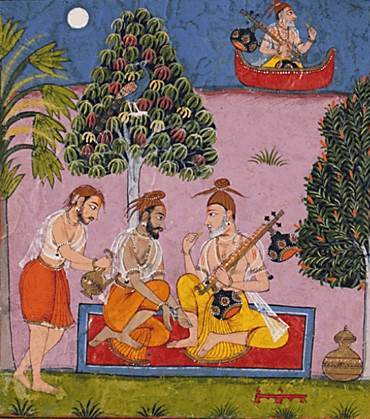
(A painting from the 17th century Mewar Ramayana, digitally preserved by the British Library)
Then, he went to his wife and questioned her, “Do you know how I maintain you all?” “No,” she responded. “Why, I am a highwayman,” he rejoined, “and for years have been robbing people; that is how I support and maintain you all. And what I now want to know is, whether you are ready to share in my sin.”
“By no means. You are my husband, and it is your duty to support me.”
The eyes of the robber were opened. “That is the way of the world — even my nearest relatives, for whom I have been robbing, will not share in my destiny.” He came back to the place where he had bound the sage, unfastened his bonds, fell at his feet, recounted everything and said, “Save me! What can I do?”
The sage said, “Give up your present course of life. You see that none of your family really loves you, so give up all these delusions. They will share your prosperity; but the moment you have nothing, they will desert you. There is none who will share in your evil, but they will all share in your good. Therefore worship Him who alone stands by us whether we are doing good or evil. He never leaves us, for love never drags down, knows no barter, no selfishness.”
Then the sage taught him how to worship. And this man left everything and went into a forest. There he went on praying and meditating until he forgot himself so entirely that the ants came and built ant-hills around him and he was quite unconscious of it.
After many years had passed, a voice came saying, “Arise, O sage!” Thus aroused he exclaimed, “Sage? I am a robber!” “No more ‘robber’,” answered the voice, “a purified sage art thou. Thine old name is gone. But now, since thy meditation was so deep and great that thou didst not remark even the ant-hills which surrounded thee, henceforth, thy name shall be Valmiki — ‘he that was born in the ant-hill’.” So, he became a sage.
Sage Valmiki’s Awakening as a Poet After Witnessing the Grief of a Female Dove
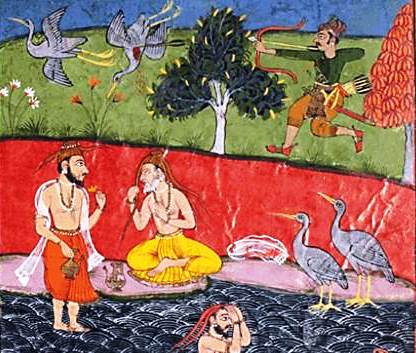
(An illustration from the Mewar Ramayana)
And this is how he became a poet. One day as this sage, Valmiki, was going to bathe in the holy river Ganga, he saw a pair of doves wheeling round and round, and kissing each other.
The sage looked up and was pleased at the sight, but in a second an arrow whisked past him and killed the male dove. As the dove fell down on the ground, the female dove went on whirling round and round the dead body of its companion in grief.
In a moment the poet became miserable, and looking round, he saw the hunter. “Thou art a wretch,” he cried, “without the smallest mercy! Thy slaying hand would not even stop for love!” “What is this? What am I saying?” the poet thought to himself, “I have never spoken in this sort of way before.” And then a voice came: “Be not afraid. This is poetry that is coming out of your mouth. Write the life of Rama in poetic language for the benefit of the world.”
And that is how the poem first began. The first verse sprang out of pits from the mouth of Valmiki, the first poet. And it was after that, that he wrote the beautiful Ramayana, “The Life of Rama”.
Story of the Ramayana Begins – The Birth of Rama
There was an ancient Indian town called Ayodhya — and it exists even in modern times. The province in which it is still located is called Oudh, and most of you may have noticed it in the map of India. That was the ancient Ayodhya. There, in ancient times, reigned a king called Dasharatha. He had three queens, but the king had not any children by them.
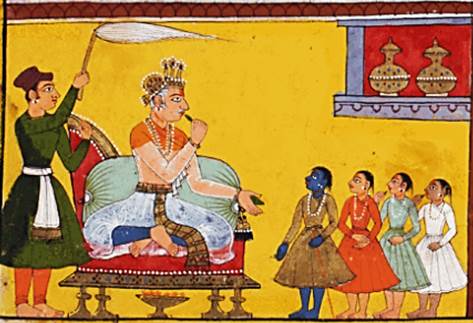
(Courtesy: Mewar Ramayana)
And like good Hindus, the king and the queens, all went on pilgrimages fasting and praying, that they might have children and, in good time, four sons were born. The eldest of them was Rama.
Now, as it should be, these four brothers were thoroughly educated in all branches of learning.
To avoid future quarrels there was in ancient India a custom for the king in his own lifetime to nominate his eldest son as his successor, the Yuvaraja, young king, as he is called.
Svayamvara of Sita – Rama Wins Sita’s Hand in Marriage
Now, there was another king, called Janaka, and this king had a beautiful daughter named Sita. Sita was found in a field; she was a daughter of the Earth, and was born without parents. The word “Sita” in ancient Sanskrit means the furrow made by a plough. In the ancient mythology of India you will find persons born of one parent only, or persons born without parents, born of sacrificial fire, born in the field, and so on — dropped from the clouds as it were. All those sorts of miraculous birth were common in the mythological lore of India.
Sita, being the daughter of the Earth, was pure and immaculate. She was brought up by King Janaka. When she was of a marriageable age, the king wanted to find a suitable husband for her.
There was an ancient Indian custom called Svayamvara, by which the princesses used to choose husbands.
A number of princes from different parts of the country were invited, and the princess in splendid array, with a garland in her hand, and accompanied by a crier who enumerated the distinctive claims of each of the royal suitors, would pass in the midst of those assembled before her, and select the prince she liked for her husband by throwing the garland of flowers round his neck. They would then be married with much pomp and grandeur.
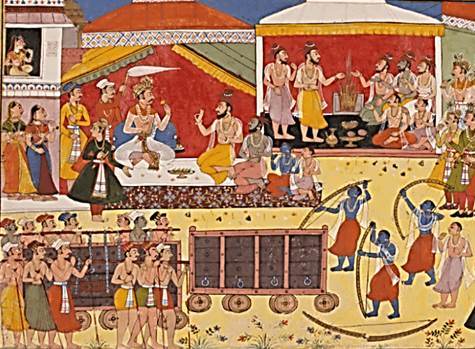
(Painting courtesy the Mewar Ramayana)
There were numbers of princes who aspired for the hand of Sita; the test demanded on this occasion was the breaking of a huge bow, called Haradhanu.
All the princes put forth all their strength to accomplish this feat, but failed. Finally, Rama took the mighty bow in his hands and with easy grace broke it in twain.
Thus Sita selected Rama, the son of King Dasharatha for her husband, and they were wedded with great rejoicings.
Then, Rama took his bride to his home, and his old father thought that the time was now come for him to retire and appoint Rama as Yuvaraja. Everything was accordingly made ready for the ceremony, and the whole country was jubilant over the affair, when the younger queen Kaikeyi was reminded by one of her maidservants of two promises made to her by the king long ago.
Ramayana Summary Continued | NEXT: Banishment of Rama and Abduction of Sita by the Demon Ravana >>

